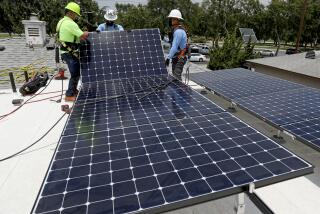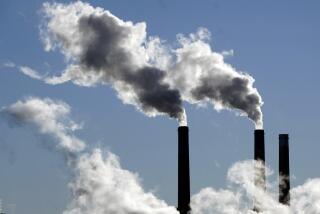Op-Ed: PG&E’s catastrophe is California’s energy opportunity

The upside of Pacific Gas and Electric’s enormous bankruptcy crisis is that it gives California officials an unparalleled opportunity to turn the state’s largest utility into an engine of decarbonization, a conduit for changes needed to carry out California’s ambitious climate goals.
Wrangling among the company’s creditors, shareholders and fire victims is likely to dominate public attention for the next two or three years, but decisions during that time about how to reorganize the utility will affect many more Californians. These decisions, in the form of actions taken by Gov. Gavin Newsom, regulators, legislators and the bankruptcy court are likely to help the company by limiting its future fire liabilities and allowing it to raise rates to cover fire costs. Such concessions should be granted only in return for reshaping the utility into a platform big enough and nimble enough to take on climate change at the scale it requires.
It is climate change, after all, that helped bring on PG&E’s bankruptcy, in the form of catastrophic fires that have left it with an estimated $30-billion liability. Global warming has also upended its business model, with nearly half of PG&E customers, according to the utility, lured away by community electricity sources that rely chiefly on renewable technologies, a shift that is likely to continue.
PG&E— or whatever entity replaces it — must be required to refit its infrastructure in the urban-wildland interface to curb fire danger.
Whether the state’s comprehensive carbon-cutting goals can be implemented remains uncertain. Senate Bill 100, passed in September, requires that California’s electricity be carbon-free by 2045. An executive order issued by former Gov. Jerry Brown commits the state’s entire economy to reach carbon neutrality by the same date, which means converting California vehicles, buildings and industries to zero-net-carbon emissions within a quarter-century.
Given the destructiveness of the wildfires, PG&E— or whatever entity replaces it — must be required to refit its infrastructure in the urban-wildland interface to curb fire danger. At the same time, it should build or remodel transmission and generation equipment to support clean energy, foster building and residential retrofits and wind down its natural gas business to nothing.
For starters, the utility can help with the replacement of fossil-fuel vehicles in the state with all-electric vehicles. The switch is essential because transportation accounts for 37% of the state’s end-use carbon emissions, making it the biggest contributor to carbon pollution of any sector. PG&E (and other utilities) can install or support electric charging stations, which must become more common than gas stations are now. Changes in electricity infrastructure can also transform the grid to enable the two-way transmission of electricity, so that, for example, cars can act as a kind of giant collective battery storing and sending electricity as well as consuming it in a renewables-intensive system.
Buildings and homes are second only to the transportation sector in statewide end-use carbon emissions, and like vehicles, they also will require a rapid all-out shift to electrification. PG&E can encourage building owners and consumers through rebates and incentives to shift from gas to electric appliances and heating.
In addition, PG&E must complete a conversion to a time-of-day rate structure, so that consumers are rewarded for using and storing electricity when demand is low, typically late at night, and limiting use when demand is highest, in the late afternoon. Incentivizing the installation of devices like electric water heaters that can keep water hot for hours until it’s needed can expedite this transition.
While electrification spreads, natural gas consumption must wither. As Panama Bartholomy, director of the Building Decarbonization Coalition, puts it, “Nobody has been able to show any path to meeting California’s climate goals that includes burning gas in buildings.” One advantage for the remaining gas-less utility is that it would have to maintain only one energy infrastructure, not two.
Enter the Fray: First takes on the news of the minute »
The shape of PG&E’s bankruptcy reorganization would be crucial to this change. For example, a split of the company into separate gas and electric utilities could be disastrous if the new gas company is allowed to pursue profits in a conventional way — it would then be likely to resist its necessary devolution into a stranded asset. But if its eventual dissolution is built into its structure, it might prove an acceptable approach.
For a hint of what’s at stake, consider that before PG&E filed for bankruptcy relief, it signed agreements to buy electricity from dozens of planned renewable energy projects — one of them, a San Jose energy storage project, alone would enable three natural gas plants to close. Now all these projects are in limbo because it’s uncertain that PG&E will honor the agreements.
Bankruptcy, says Bruce Nilles, a senior fellow at the Rocky Mountain Institute, a sustainable energy advocacy group, is “a pretty horrendous way to make policy.” But it affords PG&E a chance to repair its tattered reputation for civic-mindedness and given the urgency of addressing climate change, it presents California with a last-ditch chance to help bring the state’s energy goals within reach.
Jacques Leslie is a contributing writer to Opinion.
Follow the Opinion section on Twitter @latimesopinionand Facebook
More to Read
A cure for the common opinion
Get thought-provoking perspectives with our weekly newsletter.
You may occasionally receive promotional content from the Los Angeles Times.






